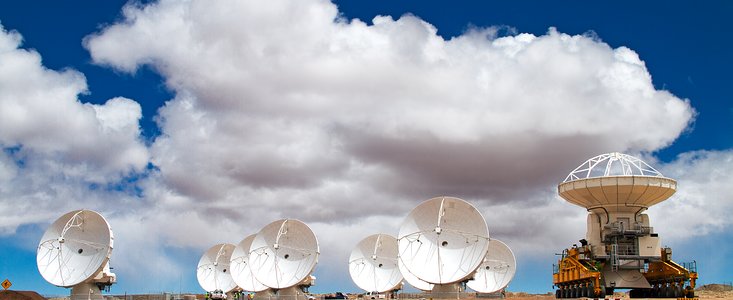Ogłoszenie
ALMA Invites Proposals for Early Science Observations
30 marca 2011
The Atacama Large Millimeter/submillimeter Array (ALMA), the most ambitious radio astronomy observatory ever built, is announcing the first opportunity for the worldwide astronomical community to submit proposals for new scientific observations. Using just 16 of the 66 state-of-the-art antennas that will be in the completed array, it will already surpass the capabilities of all existing telescopes of its kind.
ALMA is getting ready to make Early Science observations. In this phase, the telescope will be used for scientific research for the first time, even though it is still under construction. Until now, observations made with the telescope have been made purely to test that its systems work as expected.
ALMA is being built in the Andes, on the Chajnantor plateau at an altitude of 5000 metres in northern Chile. By detecting light at millimetre and submillimetre wavelengths — light invisible to the human eye and optical telescopes — ALMA will revolutionise our knowledge of the cold Universe. It will observe molecular gas and dust in our galaxy and beyond, as well as the relic radiation of the Big Bang. ALMA will study the building blocks of stars, planetary systems, galaxies and life itself.
When completed in 2013, ALMA will have 54 twelve-metre diameter antennas and an additional 12 seven-metre antennas, and will be able to work as a single huge telescope over 16 kilometres in diameter, by combining the signals from the antennas. An initial 16 twelve-metre diameter antennas will be used in the Early Science phase.
The Call for Proposals issued today, 30 March 2011, invites astronomers to draw up plans for scientific projects with ALMA, and submit them to the observatory between 1 June and 30 June. Proposals will be evaluated by a group of specialists from around the world, headed by Professor Neal Evans from the University of Texas, USA, to select those expected to make best use of the Observatory, and which will generate the most valuable scientific results during this first phase of operation.
The ALMA Regional Centres — in Europe, North America, and East Asia — are responsible in their regions for providing scientific user support to astronomers who wish to use ALMA.
The Early Science observations by ALMA are planned to start around the end of September 2011, and will last about nine months. Approximately 500–700 hours of observation time will be devoted to Early Science projects, shared between the contributing partners of Europe, North America and East Asia, and the host country of Chile. During this period, the further construction and testing of the whole array will continue in parallel.
”We are keen to start scientific observations for astronomers from all over the world," says ALMA Director, Thijs de Graauw. "At the same time we are continuing to push towards our highest priority of completing the entire array, an endeavour made possible through the global ALMA partnership. There are already another 17 antennas taking shape at the observatory site, and so progress over the coming months will be very rapid.”
The ALMA project is a partnership of Europe, North America and East Asia in cooperation with the Republic of Chile.
More Information
Full information about the technical capabilities of ALMA, how to apply for observing time, how to access ALMA data, and links to all official ALMA documents and tools can be found in the science portal.
Linki
- ALMA Science Portal
- European ALMA Regional Centre website
- North American ALMA Regional Center website
- East Asian ALMA Regional Centre website
- Information about the Call for Proposals, for astronomers
- Joint ALMA Observatory website
Kontakt
Europe:
Paola Andreani
Manager, European ALMA Regional Centre
ESO, Garching, Germany
Tel: +49 89 3200 6576
Email: pandrean@eso.org
Richard Hook
Public Information Officer
Garching, Germany
Tel: +49 89 3200 6655
Email: rhook@eso.org
Joint ALMA Observatory (Chile):
Lars-Åke Nyman
Head of Science Operations
JAO, Santiago, Chile
Tel: +56 2 467 6127
Email:
lnyman@alma.cl
William Garnier
Education and Public Outreach Officer
JAO, Santiago, Chile
Tel: +56 2 467 6119
Email: wgarnier@alma.cl
North America:
John Hibbard
North American ALMA Regional Center Manager
North American ALMA Science Center
National Radio Astronomy Observatory
Charlottesville, Virginia, USA
Tel: +1 434 296 0227
Email: jhibbard@nrao.edu
Tania Burchell
Science Writer
National Radio Astronomy Observatory
Charlottesville, Virginia, USA
Tel: +1 434 244 6812
Email: tburchel@nrao.edu
East Asia:
Sachiko K. Okumura
Manager, East Asia ALMA Regional Centre
National Astronomical Observatory of Japan
Tel: +81 422 34 3782
Email: sachiko.k.okumura@nao.ac.jp
Masaaki Hiramatsu
Education & Public Outreach officer
ALMA Project Office,
National Astronomical Observatory of Japan
Tel: +81 422 34 3900 ext. 3150
Email: hiramatsu.masaaki@nao.ac.jp
O ogłoszeniu
| Identyfikator: | ann11013 |

